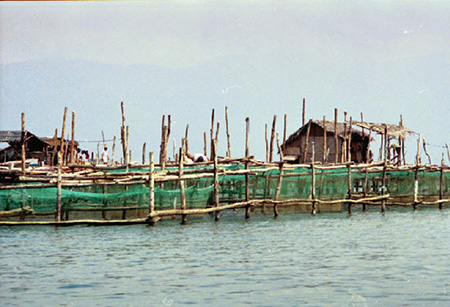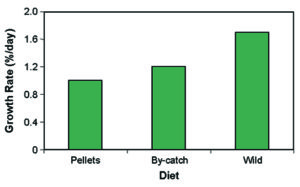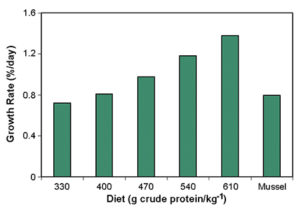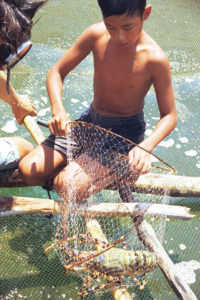Excellent growth, survival rates with pelleted feeds

The culture of tropical spiny lobsters (Panulirus ornatus) is a flourishing industry in Vietnam that had a farm gate value of about U.S. $75 million in 2001-02. Seed lobsters harvested from the wild and ongrown in sea cages grow to a market size of about 1 kg in 15-18 months.
Currently the lobsters are fed solely on fresh fishery bycatch, but its continued use is unsustainable due to competitive pressure caused by declining inshore fishery catches, poor feed conversion, and negative environmental impacts. The development of high-performing, pelleted lobster feeds is a high priority for long-term industry sustainability.
Australia studies
With the financial support of Australia’s Fisheries Research and Development Corp., the Commonwealth Scientific and Industrial Research Organisation (CSIRO) in Queensland, Australia, has carried out research on pelleted dry feeds that are palatable to juvenile tropical spiny lobsters and result in excellent growth and survival rates. The work will assist in the development of a spiny lobster aquaculture industry in Australia.
Diet development
Following preliminary studies to determine feeding behavior and responses to gross nutritional manipulation, four experiments were carried out to establish the lobsters’ requirements for critical nutrients and determine the chemical cues that stimulate sustained feeding. A summary of the experimental procedures is given in Table 1.
Irvin, Summary of experimental procedures, Table 1
| Objective | Experiment 1 Protein, Lipid Required | Experiment 2 Leachate, Preference | Experiment 3 Protein Required | Experiment 4 Astaxanthin Required |
|---|
Objective | Experiment 1 Protein, Lipid Required | Experiment 2 Leachate, Preference | Experiment 3 Protein Required | Experiment 4 Astaxanthin Required |
|---|---|---|---|---|
| Tank volume (l) | 400 | 400 | 400 | 400 |
| Initial weight (g) | 2 | 5, 80 * | 2 | 18 |
| Lobsters/tank | 10 | 7-10 | 8 | 7-10 |
| Duration (days) | 84 | 126 | 56 | 84 |
| Replicates | 4 | 4 | 4 | 4 |
Lobsters were obtained from wild populations in Trinity Inlet, Cairns. The aerated tanks were supplied with flow-through seawater of 33 to 35 ppt salinity filtered to 20 µ and heated to 29 ± 0.5 degrees-C. Sufficient hiding areas were provided for all lobsters.
Dietary protein and lipid

The initial experiment tested the growth response of juvenile lobsters to different levels of dietary protein and lipid. The pelleted diets were initially readily accepted by the lobsters. A clear dose response to protein was exhibited, with maximum growth responses at 47 and 53 percent dry matter crude protein for the 6 and 10 percent lipid diet series, respectively. However, the growth rates were below those observed in the wild or when lobsters are cultured on fresh fishery products (Fig. 1). The poor growth on the pelleted feeds was attributed to a decline in the attractiveness of the pellets within a short time of their immersion in water.
Preference testing
A second experiment addressed the question of how to sustain the lobsters’ interest in the pelleted feed. Fresh food items were included in pelleted feed as a source of natural chemical feeding cues and to relate the rate at which the chemicals leached from the feed to changes in the lobsters’ preferences.
Green-lipped mussels, school prawns, polychaete bloodworms, and squid were singularly included in the feed as homogenates at a rate equivalent to 5 percent dry matter. The rates at which dry matter, soluble and nonsoluble protein, and individual free amino acids leached from each feed and a frozen green-lipped mussel control were characterized for an immersion time of 7.5 hours.
Each of the test feeds including the control was pair tested against a commercially extruded Karuma shrimp feed previously shown to have high acceptance by the lobsters. Lobsters preferred the mussel control over that of all other feed types, whether fed fresh or after immersion in water for five hours.
Comparison of the relative intake of each feed type against the rates at which nitrogenous compounds leached from the immersed feed showed strong correlations for soluble protein and the free amino acids taurine and glycine. The authors concluded from these results that increasing the supply and prolonging the release of peptides and free amino acids from pelleted feeds was likely to prolong the lobsters’ feeding.
Dietary protein optimization

Fig. 2: Specific growth rate of spiny lobsters fed pelleted feeds with incremental amounts of
dietary crude protein or fresh mussels.
In the third experiment, which reevaluated the dietary protein specification for juvenile spiny lobsters, dried whole krill and krill hydrolysate were included in the dietary formulation as sources of the small peptides and free amino acids most likely to stimulate sustained lobster feeding responses. Feeding frequency was increased from two to four daily feeds. Fresh green-lipped mussel was included in the treatment array as a reference diet.
A clear dose response to increasing dietary protein content was observed. Lobsters fed the highest-protein diets achieved excellent growth significantly better than those fed fresh mussels (Fig. 2). Since lobster growth rose linearly with increasing dietary protein to the maximum amount investigated, it was not possible to determine an optimal dietary protein specification.
It was clear that lobsters require high-protein diets with at least 60 percent crude protein for high rates of growth. In the lobsters fed on mussels, growth rate and survival were depressed in the final four weeks of the experiment. The majority of deaths occur-red during molt, while the exoskeleton pigmentation of the surviving lobsters fed mussels was pale.
Dietary carotenoid optimization

Because of the low survival and color of lobsters fed green-lipped mussels in the third experiment, the objective of the fourth experiment was to determine the optimum dietary carotenoid specification for juvenile spiny lobsters.
Astaxanthin was added to a basal formulation containing total carotenoids of 30 milligrams per kilogram at incremental rates of 25 milligrams per kilogram to make four pelleted diets with carotenoid content ranging 30 to 105 milligrams per kilogram. The diets were fed to juvenile lobsters for 12 weeks and compared to two fresh reference diets of green-lipped mussels and blue mussels.
Increasing the astaxanthin content of the feed had no significant effect on lobster growth or survival, but correlated with an increase in the astaxanthin concentration of the lobsters’ body tissues and darkening of their exoskeletons. Again, lobsters fed pelleted diets grew significantly faster than those fed the mussel diets. A depression in growth after six weeks of feeding was observed in the lobsters fed mussels. Dietary inclusion of 50 milligrams astaxanthin per kilograms feed is advocated for good coloration and nutritional support for enhanced immunocompetence and stress resistance.
Problems with the mussel diets were likely due to micronutrient deficiency. Lobsters generally contain stores of critical micronutrients, with poor growth and mortality only exhibited after the stores are depleted.
Results from this experiment suggested the poor performance in animals fed mussels was not due to an insufficient supply of carotenoid, but other nutrient problems – perhaps cholesterol deficiency or increased vitamin loss due to the prior freezing of the mussels. In contrast to other studies with temperate spiny lobsters, frozen mussels were found unsuitable as a sole diet for tropical spiny lobsters.
Future work
A dry pelleted feed has been developed for tropical lobsters that produces excellent growth and outperforms a sole diet of frozen mussels. Using this feed as a benchmark, future work will concentrate on establishing requirements for micronutrients such as cholesterol and finding ways to reduce the inclusion rate of expensive marine protein ingredients without lowering diet performance.
(Editor’s Note: This article was originally published in the October 2004 print edition of the Global Aquaculture Advocate.)
Now that you've finished reading the article ...
… we hope you’ll consider supporting our mission to document the evolution of the global aquaculture industry and share our vast network of contributors’ expansive knowledge every week.
By becoming a Global Seafood Alliance member, you’re ensuring that all of the pre-competitive work we do through member benefits, resources and events can continue. Individual membership costs just $50 a year. GSA individual and corporate members receive complimentary access to a series of GOAL virtual events beginning in April. Join now.
Not a GSA member? Join us.
Authors
-
Simon J. Irvin
Commonwealth Scientific and Industrial Research Organisation
Marine Research
P.O. Box 120
Cleveland, Queensland 4163
Australia -
Kevin C. Williams
Commonwealth Scientific and Industrial Research Organisation
Marine Research
P.O. Box 120
Cleveland, Queensland 4163
Australia
Tagged With
Related Posts

Responsibility
Hatchery production of spiny lobsters
Spiny lobsters are a premium seafood whose culture has depended on wild-caught seedstock. An Australian company is helping shift the farming paradigm to more sustainable hatchery production.

Responsibility
Advancing the ecosystem services of aquaculture
The Nature Conservancy was inactive in aquaculture until new program leader Robert Jones joined. His focus is on the positive outcomes of responsible aquaculture.

Intelligence
Enzymes in seafood, part 1
Enzymes are responsible for postharvest changes in seafood that impact product characteristics and reduce value. The odor of seafood is a direct result of enzyme activity.

Responsibility
Floating raceways provide option for marine fish fingerling production
Floating raceways can be put in ponds, reservoirs, or sheltered waters as small-scale production systems for fingerlings or short-term nursery environments.


